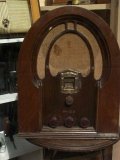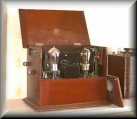The word lobby and the sound brigade (research)
|
Beck, Alan, 2000, 'Playing by ear: new ways of teaching and researching radio drama', Studies in Theatre and Performance 1.1 The word lobby and the sound brigade In one of her thoughtfully succinct radio columns in 'The Guardian', now regretfully no more, Anne Karpf summarised radio drama styles: Exponents of radio drama … seem to fall into two camps - the word lobby and the sound brigade. And she quotes from B.B.C. director Jeremy Mortimer, responsible for 'art' plays: Radio plays are too often packed with words, as if the writer is desperate to fit in as much information as possible to compensate for not having pictures. But one of the sounds you need in radio drama is silence. Radio is very much like film in its perspective and depth of focus - you can zoom in to things and then leave it quiet. (Karpf 1994) Jeremy Mortimer refers here to what I call the 'filmic' directing style in radio drama. It offers more sound scenery, and accentuates sound perspective and the 'mise en scène'. It pulls these other aspects to the 'front' of the sound picture, rather than keeping the words solely in the foreground and the location dimly in the background. The director can edit sound 'shots', partly through differing microphone positions. The 'filmic' can reproduce in some respects film's 'look' - a sensation in the listener that it is she or he who is producing the sound pictures and tracking glances to their targets. Radio 'filmic' direction can also work through the interiorizing monologue (the voice in the mind or what film terms 'internal focalization'), through cross-cutting the monologue with realistic dialogue (a technique at which Jeremy Mortimer is particularly skilled) and also through distanciating devices. (An application of this analysis is in Beck, 2000, 'Listener positioning'.) More adventurously, a 'filmic'-style radio director can introduce textures and layering of sounds, multiple perspectives and the range of formalist techniques that are now so popular in feature films, partly because of digital production. Unfortunately, experiments like this are all too few.
1.2 'Word lobby' and radio dialogue But the 'word lobby' is often splendidly successful. Most of radio drama's gestures in time and space are verbal. Suiting the main genres broadcast, characters are usually highly articulate. Radio characters assault and interrogate language at the level of the word; while in the sight/sound media, subtext and the gaps between words run parallel. Note 1 Often, radio characters use word tricks and wit, which disrupt dialogue by denying its logic. Their rhythms are those of the continuous sonic stream of radio, neither the many varied tempi of real-life interaction nor the tempi of film and stage. Whereas verbal discourse in radio drama must be over-determined to compensate, its space and time are, by contrast, inherently ambiguous and often opaque. There is an in-built tension here, and another reason for the nearly total foregrounding of the verbal in microphone positions 1, 2 and 3 (Beck, 1997, 48-57). Hence the speed of standard B.B.C. production. This is half an hour broadcast product for a day in the studio - suited to the word-based skills, training and praxis of the British, 'cool', technique actor, and resistant to other systems. Obvious examples of these latter include living the life of the character, working inside-out, extensive table work, improvisation, as also the high-energy vocal stream of the American Wooster Group. Back to SOME OPENING STATEMENTS |
|
|



